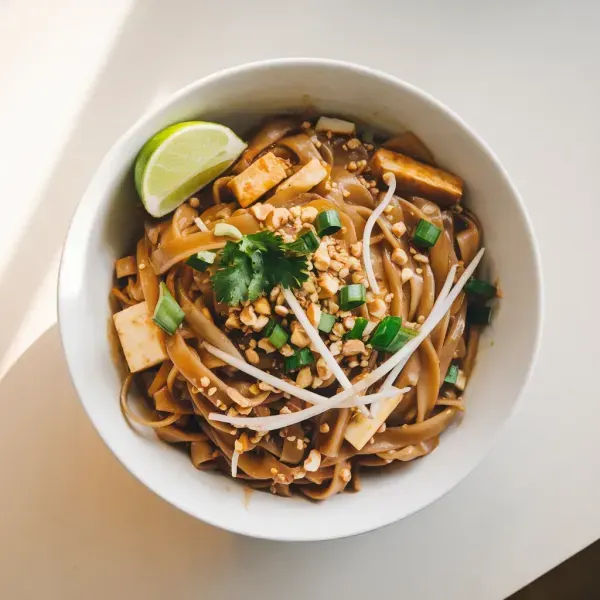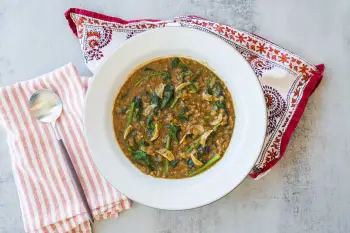
 45 minutes
45 minutesDelve into the world of Thai cuisine with this authentic Pad Thai recipe, a perfect combination of noodles, proteins, and savory sauce.


Pad Thai Noodles, soaked
0 oz
0.25 fluid ounces
Tamarind Liquid
0.25 fluid ounces
0 oz
Garlic, minced
cloves
Shallots, minced
each
Preserved Sweet Radish, minced
oz
Shrimp, peeled and deveined
0 oz
Firm Tofu, cut into bite-size morsels
0 oz
Eggs, lightly beaten
each
Bean sprouts, washed
0 oz
Garlic Chives Or Scallion Greens, chopped
0 oz
tablespoons
Chopped Peanuts
0 oz
to taste
Lime
0 wedges
1. Noodle Soak
Begin by preparing your pad Thai noodles. Take 8 ounces of noodles and submerge them in a large bowl of warm water. Let them soak for 20 to 30 minutes, just until they're pliable but still firm to the touch. This is crucial for achieving that perfect chewy texture in your final dish.
2. Savory Sauce Creation
While the noodles bathe, concoct the heart of your Pad Thai. In a small saucepan, whisk together 1/3 cup each of fish sauce, tamarind liquid, and coconut sugar over low heat. Stir until the sugar dissolves, which should take about 3 to 4 minutes. This trio brings the essential sweet, tangy, and umami notes to your dish.
3. Prep Your Ingredients
Line up all the components for your culinary masterpiece. Mince your garlic and shallot, and if you're using it, your sweet preserved radish. Have your shrimp peeled and deveined, tofu cut into bite-size morsels, eggs lightly beaten, bean sprouts washed, and garlic chives or scallion greens chopped. Organizing ingredients before you fire up the stove makes for a seamless cooking experience.
4. Tantalizing Stir-Fry
Heat 3 tablespoons of vegetable oil in a large wok or skillet over medium-high flame. Toss in the garlic, shallot, radish if using, and shrimp, stir-frying for a couple of minutes until the shrimp turns pink and everything is fragrant.
5. Infuse with Tofu
Add the tofu to the wok, letting it heat through for about 2 minutes. It should start to take on a little color, becoming a sponge for all the surrounding flavors.
6. Noodle Magic
Now, introduce the soaked noodles and pour in half of your prepared sauce, adding a tablespoon of water to help the noodles steam. Keep the heat high and the ingredients moving. The noodles will begin to sizzle, soaking up the sauce and transforming in texture. Add more sauce and water as needed, tasting as you go to ensure the balance of flavors is just right.
7. Egg Ribboning
Push your noodles to the side and drizzle a little more oil into the pan if necessary. Pour in the beaten eggs, letting them settle for a few seconds before scrambling them into soft curds. Then, swiftly combine them with the noodles, allowing the eggs to ribbon through the dish.
8. Final Flourish
Fold in the bean sprouts and chives, cooking briefly just until they're warmed through but still crunchy, offering a fresh contrast to the soft noodles and rich eggs.
9. Plate and Personalize
Serve your Pad Thai hot, inviting each diner to top their plate with a generous sprinkle of chopped peanuts for crunch, a dusting of chile powder for heat, and a squeeze of lime for a final zesty kick. Each bite should be a harmonious blend of textures and flavors, a true testament to the timeless appeal of this Thai classic.




Comments (0)